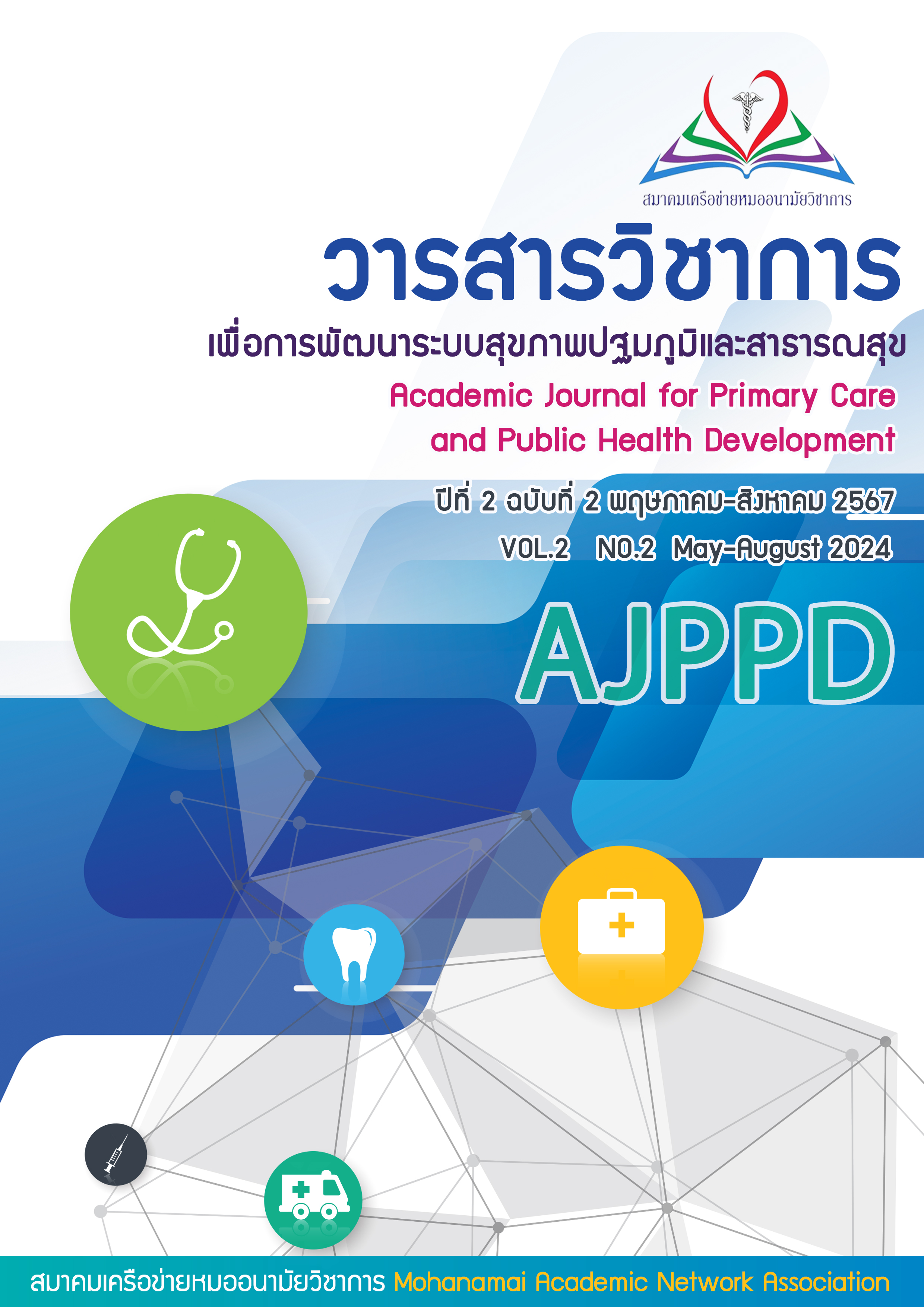Factors associated with performance outcomes of public health personnel under health promotion indicators in Krabi Province
Keywords:
Public Health Personnel, Performance Effectiveness, Health PromotionAbstract
This research aims to: 1. Explore the factors related to the effectiveness of public health personnel's performance under the health promotion indicators of Krabi province; 2. Investigate personal factors, internal factors, and external factors affecting the performance of public health personnel under the health promotion indicators of Krabi province through a survey study using questionnaires. The study population consists of health promotion public health personnel in state health departments in Krabi province. The results revealed that personal, internal, and external factors are significantly correlated with the performance of public health personnel at a 0.01 level of significance. Furthermore, personal, internal, and external factors significantly impact the overall performance effectiveness at a .05 level of statistical significance. To sustain morale and motivation over the long term, agencies should prioritize enhancing motivational aspects such as rewards and welfare benefits. Concurrently, promoting mental health alongside physical health through diverse activities can foster a supportive work environment and continuous positive team relationships
References
กระทรวงสาธารณสุข. (2565). แผนติดตามผลการดำเนินงานโครงการสำคัญ ของกระทรวงสาธารณสุข ประจำปีงบประมาณ พ.ศ. 2565. กองยุทธศาสตร์และแผนงาน สำนักงานปลัดกระทรวงสาธารณสุข.
กระทรวงสาธารณสุข. (2565). รายงานผลการประเมินแผนปฏิบัติราชการกระทรวงสาธารณสุขสู่ความเป็นเลิศ ประจำปีงบประมาณ 2565. กองยุทธศาสตร์และแผนงาน สำนักงานปลัดกระทรวงสาธารณสุข.
กระทรวงสาธารณสุข. (2566). รายงานผลการประเมินแผนปฏิบัติราชการกระทรวงสาธารณสุขสู่ความเป็นเลิศ ปีงบประมาณ 2566. กองยุทธศาสตร์และแผนงาน สำนักงานปลัดกระทรวงสาธารณสุข.
นิศาชล รัตนมณี และประสพชัย พสุนนท์. (2562). อัตราการตอบกลับของแบบสอบถามในงานวิจัยเชิงปริมาณ. วารสารมนุษยศาสตร์และสังคมศาสตร์ มหาวิทยาลัยธนบุรี, 13(3), 181-188.
Aeknarajindawat, N., Aeknarajindawat, N., & Aswasuntrangkul, D. (2020). Role of High? Performance Work Practices on Performance in Pharmaceutical Business in Thailand. Systematic Reviews in Pharmacy, 11, 57-66. https://doi.org/10.5530/SRP.2020.3.07.
Al-Enazi, W., Ahmed, A. S., & Mahanti, A. (2022). Key factors influencing hospital efficiency: A systematic review. BMC Health Services Research, 22(1), 1-14.
Best, J. W. (1977). Research in Education (3rd ed.). Englewood Cliffs, NJ: Prentice-Hall.
Bhat, Z. (2011). Impact of Training on Employee Performance: A Study of Retail Banking Sector in India. Indian journal of applied research, 3, 292-293. https://doi.org/10.15373/2249555X/JUNE2013/97.
Dikshit, A., & Jain, T. (2017). Training and Skill Development for Employee Retention and Performance Enhancement in Banks. PSN: Financial Institutions (Topic). https://doi.org/10.2139/ssrn.2984442.
Gibran, N., & Ramadani, D. (2021). The Effect of Training and Career Development on Employee Performance. Almana : Jurnal Manajemen dan Bisnis. https://doi.org/10.36555/almana.v5i3.1680.
Gorla, N., Somers, T., & Wong, B. (2010). Organizational impact of system quality, information quality, and service quality. J. Strateg. Inf. Syst., 19, 207-228. https://doi.org/10.1016/j.jsis.2010.05.001.
Herzberg, F., Mausner, B., & Snyderman, B. B. (1959). The Motivation to Work. New York: John Wiley & Sons.
Khan, S., & Abdullah, N. (2019). The impact of staff training and development on teachers’ productivity. Economics, Management and Sustainability. https://doi.org/10.14254/JEMS.2019.4-1.4.
Lowe, M. M., Bennett, N., & Aparicio, A. (2009). The role of audience characteristics and external factors in continuing medical education and physician change: effectiveness of continuing medical education: American College of Chest Physicians Evidence-Based Educational Guidelines. Chest, 135(3), 56S-61S.
Lundstrom, T., Pugliese, G., Bartley, J., Cox, J., & Guither, C. (2002). Organizational and environmental factors that affect worker health and safety and patient outcomes. American Journal of Infection Control, 30(2), 93-106.
Misau, M. (2023). Revisiting the Concept of Human Resource Management. Global Academic Journal of Economics and Business. https://doi.org/10.36348/gajeb.2023.v05i03.002.
Platis, C., Reklitis, P., & Zimeras, S. U. L. F. U. R. (2015). Relation between job satisfaction and job performance in healthcare services. PROCEDIA-Social and behavioral sciences, 175, 480-487.
Shojaei, A., Ketabi, R., Razkenari, M., Hakim, H., & Wang, J. (2021). Enabling a circular economy in the built environment sector through blockchain technology. Journal of Cleaner Production, 294, 126352.
Solossa, A. A., Rantetampang, A. L., & Sandjaja, B. (2015). Determinants of employee performance in the health sector in Makassar City. Journal of Management and Business Studies, 2(1), 13-18.
Zubairi, D., & Khan, T. (2018). THE EFFECT OF TRAINING AND DEVELOPMENT ON JOB SATISFACTION, SKILL ENHANCEMENT AND MOTIVATION OF EMPLOYEES. International Journal of Research -GRANTHAALAYAH. https://doi.org/10.29121/granthaalayah.v6.i11.2018.1130.

Downloads
Published
How to Cite
Issue
Section
License

This work is licensed under a Creative Commons Attribution-NonCommercial-NoDerivatives 4.0 International License.




